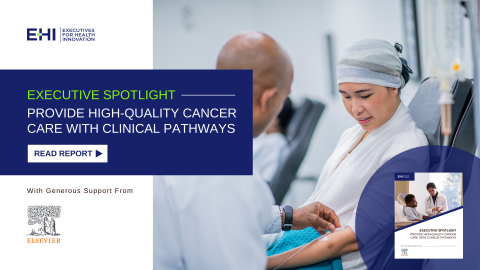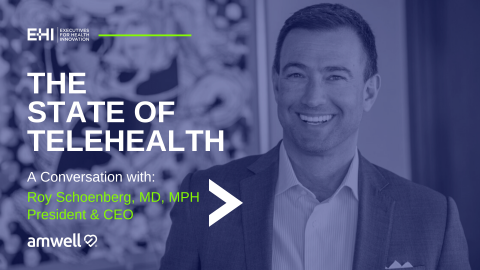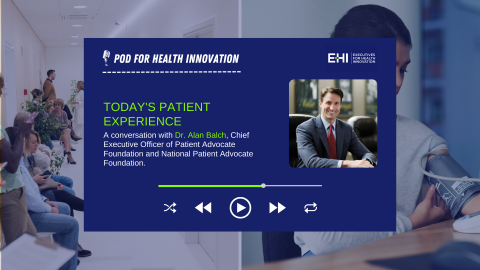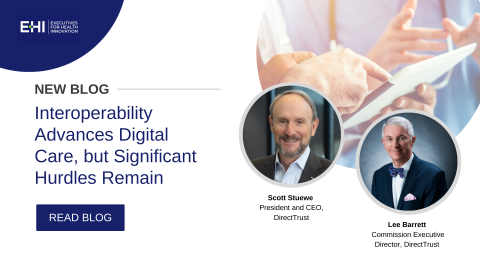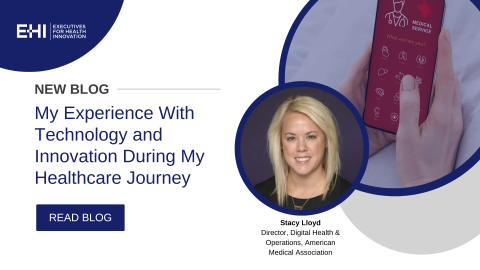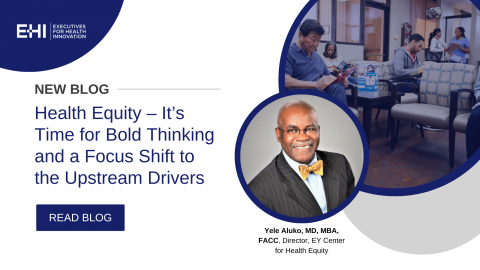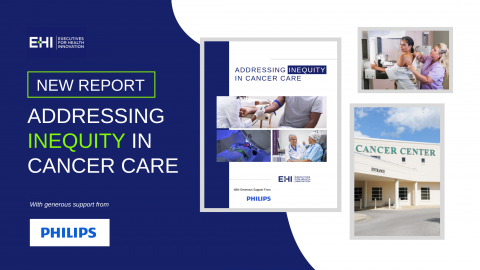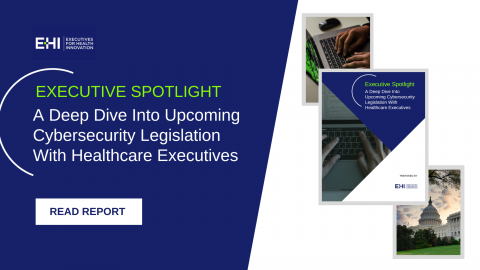Executive Spotlight: Provide High-Quality Cancer Care with Clinical Pathways
Overview
Clinical pathways enable providers to deliver evidence-based healthcare to patients. They provide treatment guidance based on the latest research and support standardization of care. Oncology practices implement pathways to ensure care is at the highest standard of quality, access, affordability, and health outcome.
Executives for Health Innovation (EHI) convened a group of oncologists and pathway experts at an executive roundtable, followed by a public webinar. The group discussed the appropriate use of clinical pathways in oncology and answered relevant questions around the topic from other oncology leaders.
This report highlights key takeaways from those discussions.
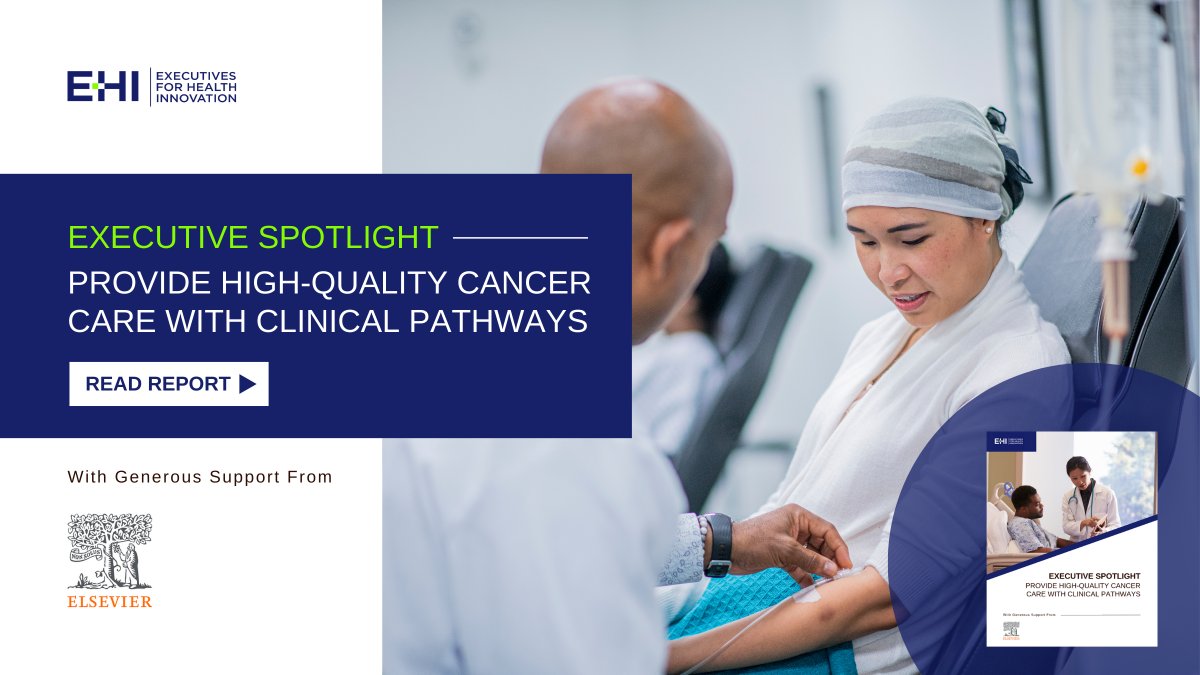
EHI thanks Elsevier for their generous support of our organization’s work addressing digital care and innovations improving health.

Interview: The State of Telehealth with Dr. Roy Schoenberg
During this timely interview, EHI CEO, Jen Covich Bordenick, spoke to Dr. Roy Schoenberg, president & chief executive officer of Amwell to address the current state of telehealth. Dr. Schoenberg gave his thoughts on what he believes the future of this dynamic technology looks like.
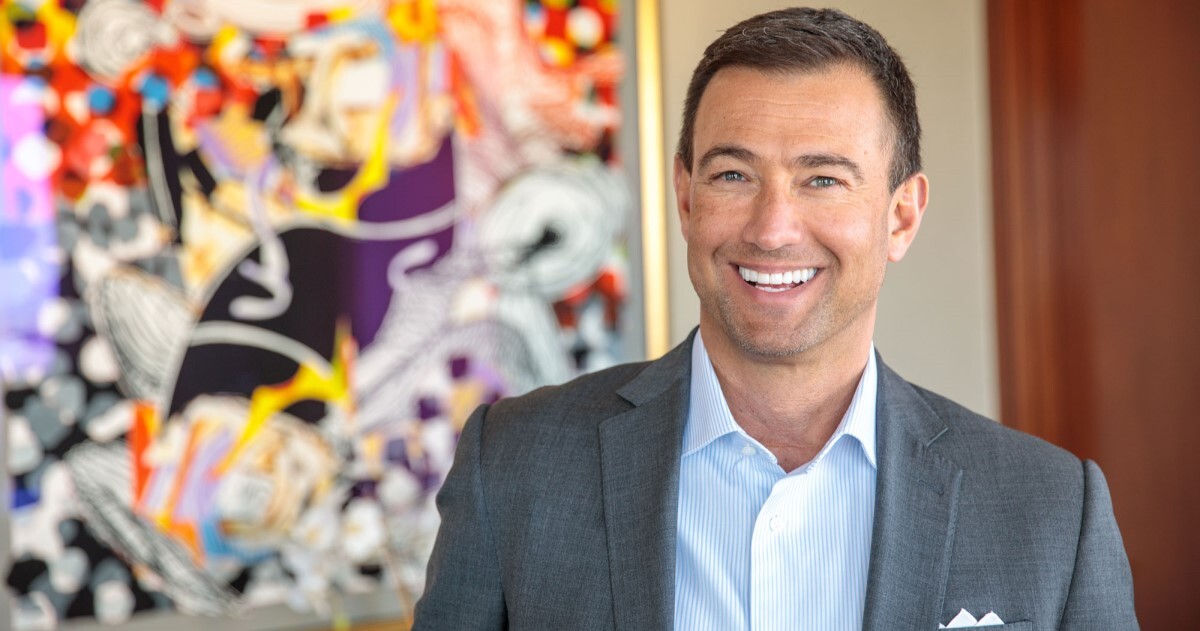
Roy Schoenberg, MD, MPH
President & CEO
Amwell
Dr. Roy Schoenberg is President and CEO of Amwell. Since co-founding the company with his brother Ido Schoenberg, Amwell has grown to become one of the largest telehealth eco-systems in the world, digitally connecting healthcare’s key stakeholders - payers, providers, and millions of patients in an efficient, modern healthcare experience. Prior to Amwell, Roy was the founder of CareKey and served as Chief Information Security Officer at TriZetto, following its acquisition of CareKey. In 2013, Roy was appointed to the Federation of State Medical Boards’ Taskforce that issued the landmark guidelines for the “Appropriate Use of Telemedicine in the Practice of Medicine”. Roy was named one of Modern Healthcare’s 100 Most Influential People in Healthcare in 2020 and is the 2014 recipient of the American Telemedicine Association Industry award for leadership in the field of telemedicine. An inventor at heart, Roy holds over 50 issued US Patents in the area of healthcare technology, speaks frequently in industry and policy forums, serves on the healthcare advisory board of MIT Sloan, holds an MD from the Hebrew University and an MPH from Harvard. He is a sailor, scuba-diver, and, between September and February, a devoted football fan.

Podcast: A Conversation with Dr. Alan Balch on Today's Patient Experience
Overview
During this episode, we had the pleasure of speaking with Dr. Alan Balch, chief executive officer of Patient Advocate Foundation and National Patient Advocate Foundation. Dr. Balch addresses the challenges and obstacles that patients face today when attempting to access and/or receive care in the U.S. healthcare system. In addition, Dr. Balch describes the Advocate Foundation and National Patient Advocate Foundation's important work in helping patients navigate a complex system to receive needed care.

Alan Balch, PhD
Chief Executive Officer
Patient Advocate Foundation and National Patient Advocate Foundation
Dr. Balch is the Chief Executive Officer of Patient Advocate Foundation and National Patient Advocate Foundation.
Dr. Balch has nearly fifteen years of executive leadership in the non-profit sector with an emphasis on consensus-building and collaboration. He has led numerous federal advocacy efforts on a range of issues both at the legislative and regulatory level over the years. He became the CEO of both PAF and NPAF in 2013. From 2006 – 2013, he served as the Vice President of the Preventive Health Partnership — a national health promotion collaboration between the American Cancer Society, American Diabetes Association, and American Heart Association. Prior to his work with the Preventive Health Partnership, Dr. Balch was the Executive Director of Friends of Cancer Research.
Dr. Balch has served on the Executive Board of the Patient Advocate Foundation and National Patient Advocate Foundation since 2007. Dr. Balch also serves on numerous advisory boards and committees
He earned his PhD in environmental studies with a concentration in political economy in 2003 from the University of California, Santa Cruz; his master’s degree in environmental sciences in 1997 from the University of Texas in San Antonio; his bachelor’s degree (cum laude) in biology in 1994 from Trinity University in San Antonio.
Blog: Interoperability Advances Digital Care, but Significant Hurdles Remain
The prospect of truly interoperable patient health data leapt forward in February when the Department of Health and Human Services announced six entities in line to be qualified to serve as data exchange hubs.
If each interoperability step is a building block to the patient data equivalent of an interstate, this announcement forms a key connector for the nationwide data highway. But the interstate is nowhere near complete, so celebrations are premature. It’s a critical and encouraging step, to be sure, but connecting provider systems is a complicated business.
The healthcare industry remains a prime target for cybersecurity attacks, with 700 incidents in 2022 compromising 51.4 million patient records. Connecting networks across the country will exacerbate the vulnerabilities — unless sufficient care is taken at every step to ensure data protection and privacy.
Interoperability carries with it the possibility of transforming patient care and improving outcomes by expanding data access. Imagine accurate and up-to-date data flowing among caregivers as a patient moves from care setting to care setting, provider to provider, with providers and staff spending less time locating, aggregating, and digesting data and more time on direct patient care. Free-flowing data eliminates much of the paperwork patients must fill out over and over again.
Yes, the promise of interoperability is real and exciting, and the healthcare industry is closer than ever to achieving this elusive aim. The next steps will be equally as critical in making interoperability a reality that serves both providers and patients.
Interoperability Will Improve Patient Care Outcomes
Imagine the all too frequent example: an individual is transported to the local emergency department after an automobile accident and needs immediate surgery. They are unresponsive, and their driver’s license indicates the individual is not local. Personnel can’t find in case of emergency (ICE) information on their phone, and there was no one else in the vehicle who could provide any medical details.
The patient needs immediate surgery, but any procedure could be deadly absent information about medical conditions such as whether the patient is taking blood thinners or has comorbidities that could impact the surgery and outcome. But the patient cannot wait, so the surgery proceeds.
Now imagine the same scenario with national interoperability of patient records. With a driver’s license, personnel quickly locate the patient’s record, see the patient isn’t taking a blood thinner and doesn’t have comorbidities that could affect the needed surgery, which proceeds in full knowledge of the person’s health status.
A patient doesn’t need to suffer a life-threatening accident to fall victim to bad or incomplete information. In 2017, the Joint Commission issued a Sentinel Event Alert on the potential for patient harm arising from insufficient patient handoffs. Caregivers along the continuum must understand a patient’s condition, treatment, medications, comorbidities, and more to start the next step on a patient’s care journey. Federal mandates for admission, discharge, and transfer (ADT) notifications are helping in this area. There’s no doubt interoperability can make those handoffs more meaningful and improve overall patient outcomes.
Meaningful Data Exchange Closer than Ever
The Trusted Exchange Framework and Common Agreement (TEFCA) was born out of the 21st Century Cures Act, passed on a bipartisan basis in the closing days of the Obama administration. The legislation did several things, including defining and making information blocking illegal and allowing patients to access their health data through application programming interfaces (APIs) and an “app of their choosing.” It also set up the initial framework for TEFCA, although the first draft of guidelines wasn’t released until 2018.
Even before the Cures Act, the industry was moving toward interoperability on its own. Providers in geographic areas were coming together to form local, regional, or state health information exchanges (HIEs), and health systems were promoting interoperability among member facilities. The CommonWell Health Alliance got its start in 2013, with the intention to build a shared infrastructure for members, followed a few months later by Carequality and its common standards used by vendor-based networks. In 2015, CommonWell and Carequality created a bridge allowing exchange between the two.
The culminating action for TEFCA is the application acceptance of the first qualified health information networks (QHINs) in February: CommonWell, eHealth Exchange, Epic TEFCA Interoperability Services, Health Gorilla, Kno2, and KONZA National Network. Together the prospective QHINs cover all 50 states, conducting billions of transactions for most hospitals and tens of thousands of providers. The final approval and ramp-up process is expected to take a year.
National Coordinator for Health IT Micky Tripathi also recognized the next big challenge, saying that “strong privacy and security protections are required of QHINs.” He noted that greater interoperability “will help improve the quality, safety, affordability, efficiency, and equitability of health care across the country.”
Data Duplication, Integration Issues Still to be Solved
Getting QHINs up and running will not completely solve the interoperability challenge, for several reasons. Data duplication is the first issue that needs to be tackled. Think about the new patient paperwork completed on a first visit and then annually, multiplied by the number of physicians, specialists, and facilities that a patient visits. Who remembers what year that surgery took place or what Grandpa died from and when? When presented with duplicative information that may be contradictory, what takes precedence?
The provider experience also cannot be overlooked. The goal is to bring data together and present it in a way that’s useful for providers. However, providers are notorious for dis-adopting technology that doesn’t conform to their workflows. How many times has the death knell tolled for the fax machine amid technology advances designed to transmit data more reliably and securely?
Although the industry is moving toward value-based care, we aren’t there yet. In a fee-for-service environment, exchanging data with other providers is often seen as “leakage,” as patients move among providers and care settings.
At this time, interoperability is essentially voluntary. The federal government used financial incentives to achieve the widespread adoption of EHRs and e-prescribing. Until financial incentives are provided for interoperability, adoption may lag.
Cyber Threats Undermine Trust and Inhibit Exchange
One of the most pressing issues slowing widespread interoperability is the security of networks that will exchange data. A research brief from the ONC shows many organizations already have multiple connections to other data networks, with 6% reporting four or more connections. That doesn’t include the connections among provider systems, which can number in the hundreds for a single hospital.
Every data connection opens up another possible penetration point for hackers and bad actors. Health data is highly prized, and the average cost of remediation among healthcare organizations passed $10 million in 2022 — twice the cost of financial services, the second-most breached industry. Because of significant payouts, cyber insurance companies are tightening coverage requirements, and we believe insurers soon will routinely require third-party risk management to attest to the security of a hospital’s network infrastructure, including devices and business associates.
It's not a question of if an organization gets breached: It’s a question of when and how significant the impact will be on patient care. Organizations must have appropriate and rigorous policies and procedures in place. Ideally, they would be certified by a third party based on cybersecurity standards adopted by the National Institute of Standards and Technology.
Among trusted communication methods, sending and receiving data using Direct Secure Messaging (often called Direct) over the DirectTrust network operated by accredited organizations had the most universal usage, with adoption by 90% of hospitals. Direct is a proven technology that serves more than 282,000 organizations. In Q4 2022, 213 million messages flowed through the DirectTrust network. It is the inherent security of the protocol itself and the certification of network operators that has enabled such broad adoption.
The final unanswered question is how consumers will access their own data while maintaining privacy and security. App developers are governed by the Federal Trade Commission, not HIPAA, so it’s critical the right guardrails be developed so patients can confidently access their data. DirectTrust is working with The CARIN Alliance, a consumer-directed data exchange collaborative, on a new accreditation program to help bring that confidence to consumers.
Conclusion
The naming of the first QHINs represents a giant step forward for the interoperability and access of patient data. But the data exchange highway isn’t yet complete. The healthcare industry needs continued diligence to solve the remaining issues, including how to maintain the privacy and security of data as it flows through an increasing number of IT networks.
Third-party certification can provide the right security guardrails by setting high, yet achievable standards around IT networks and their ability to access and exchange data.
About the Authors

Scott Stuewe
President and CEO
DirectTrust
Scott Stuewe is a 25+ year veteran of the healthcare information technology industry. As President and CEO of DirectTrust, Scott drives visibility and utilization of the Direct Standard™ to contribute to nationwide interoperability. Under his tenure, the organization achieved the landmark milestones of one, two, and three billion Direct Secure Messages sent and received over the DirectTrust Network. Previously, Stuewe was Director of Strategy and Interoperability at DataFile Technologies, a health information management company, and served more than 24 years at Cerner, including as Cerner Network’s Director of National Interoperability Strategy, where he drove participation in the CommonWell Health Alliance and the bridge with Carequality.

Lee Barrett
Commission Executive Director
DirectTrust
Lee Barrett is the Commission Executive Director for DirectTrust. He previously served as CEO and Executive Director of the Electronic Healthcare Network Accreditation Commission (EHNAC), which merged into DirectTrust in January of 2023. He was appointed by the Office of the National Coordinator for Health Information Technology (ONC) as FAST co-lead of the Testing and Certification Tiger Team and as a member of the Executive Committee. Barrett currently serves as a member of the HHS 405(d) Cybersecurity Information Sharing Act (CISA), the FAST/HL7 Accelerator, the Healthcare Sector Cybersecurity Council (HSCC), and the EHI Leadership Council, and is also a board member for The Sequoia Project and co-chair of the Sequoia Interoperability Matters Leadership Council.
Blog: My Experience With Technology and Innovation During My Healthcare Journey
As I think about the patient experience and how it’s evolved over the years, I am optimistic about the continued transition away from patient satisfaction scores on a Press Ganey survey and towards a more holistic approach to thinking about how patients and caregivers navigate, access, use and experience the broader healthcare system. Patient experience was a priority for many health systems prior to the COVID-19 pandemic, but the way care is delivered has drastically changed since then, and so have patient expectations.
Improving the patient experience is personal for me. At the age of 10, I was life-flighted to Children’s Hospital of Pittsburgh with a blood pressure of 240/120. I would soon be diagnosed with Pheochromocytoma, a type of tumor found on the adrenal glands that causes hypertension and various other symptoms. I spent a majority of the next month in the hospital being stabilized, followed by a 12-hour surgery to remove two tumors. Following another 10-hour surgery for a similar tumor three years later, my family was sent to the National Institutes of Health for further testing.
I was officially diagnosed with a rare, genetic disease called Von Hippel-Lindau (VHL), which causes people to grow tumors in up to ten (10) areas of the body. There’s currently no cure and surgery is the most common form of treatment (if and when it’s possible). This diagnosis started a trajectory that would change my life forever and truly require me to rely on the healthcare system for the rest of my life. Since those early years, eight (8) other members of my family have been diagnosed with VHL, I’ve had two (2) additional related surgeries, and I complete annual surveillance that includes MRIs, CTs, blood work, eye exams, etc.
The use of healthcare technology and innovation is a critically important aspect of care delivery for patients, and it has and will continue to play a major role in my healthcare journey. While I got sick at a time that healthcare tech consisted of EHRs at best, as I’ve gotten older and the industry has evolved, digital health has become a regular in my care routine in a few ways.
Tools that help coordinate care
I’ve moved across states multiple times and have had to identify new care teams. I’ve leveraged patient portals to access, secure, and/or share my medical records with new clinicians ahead of my first visit. Patient portals have also been a helpful way for me to remain engaged by viewing my results and comparing them against past years, and have made it easier to request appointments and/or ask questions to my physicians. Digital front doors can provide positive experiences for patients if done right and truly support patients in navigating the system.
I have also used a tool that records conversations with my physician to refer back to later. The app provides transcription of the visit that helps break down the medical terminology, provides information on potential prescription and pharmacy options for medications, and helps me identify questions that may come up after the visit. This can be a powerful tool to be able to share information with family members and for patients with new diagnoses.
Virtual care options
The expansion of telehealth in 2020 was a welcome resource for many patients, including myself, to continue to seek care when offices were closed. Being able to still receive my annual surveillance screening gave me peace of mind in a stressful time. Telehealth has also emerged as a way to expand access to clinical experts within centers of excellence across rare and complex health conditions creating opportunities for improved, coordinated, quality of care, especially across the VHL community. That access to virtual care has become an expectation and frankly, a lifetime, for many patients.
Remote monitoring has also been a crucial part of my healthcare journey. As a result of my disease, I am prone to high blood pressure. Being able to access validated devices that can accurately take BPs at home and report back to my physician supports a more comprehensive understanding of my health outside of the four walls of a clinic. Continued expansion of remote monitoring will provide opportunities for patients to be more engaged in their care, reduce trips to the doctor’s office, and hopefully provide better overall outcomes.
Healthy lifestyle support
Digital health for wellness isn’t always a part of traditional patient experience discussions because there is little integration with the actual health care system, but it is worth mentioning as it’s an important area of digital health that many patients are using independently to manage diet, exercise, sleep and other lifestyle behaviors. For me, it is an important component to my healthcare journey to ensure I’m doing everything I can do to stay healthy and be ready to manage any challenges with my VHL.
An area I have not personally had to experience (yet), but I am excited to see expanding is the decentralized clinical trial space. Clinical trials have historically lacked access and diversity, and this is a step in the right direction that can make a difference for so many patients that would have otherwise not had access to life-saving treatments.
My experience truly just scratches the surface of how digital health can positively impact the patient experience. There has been a significant amount of progress in digital health, but there’s still work to be done to realize it’s full potential. Key opportunities I’m interested in include enhanced care coordination support, expansion of access, and more personalized approaches to treatment and care for patients. There is also some “low hanging fruit” in the administrative areas of the healthcare system that could transform the patient experience, for example, obtaining medical records, scheduling appointments, cost transparency, and support understanding and paying bills.
Unfortunately, for most, healthcare experiences are still clunky, manual, and frustrating, even for the savviest of patients. The key to continuing to make progress in improving patient experiences across the industry is to listen to and incorporate the patient voice into the design, development, and implementation of products, solutions, and services.
About the Author:

Stacy Lloyd
Director, Digital Health & Operations
American Medical Association
Stacy Lloyd is currently the Director of Digital Health and Operations at the American Medical Association. She has over 15 years of experience in finance and operations, digital health, innovation, and patient advocacy at leading healthcare organizations. Stacy also holds a Bachelors in Business Administration from Duquesne University and a Masters in Public Health from the University of Illinois at Chicago, and is a Board Certified Patient Advocate.
Stacy was diagnosed with VHL in 1999 at the age of 13. Since then, several other members of her family have also been diagnosed with the disease. She is personally and professionally invested in the future of healthcare and enjoys being a resource in this space for family, friends and other patients, so that they can be better informed and empowered in their own healthcare journeys.
Blog: Health Equity – It’s Time for Bold Thinking and a Focus Shift to the Upstream Drivers
Yele Aluko MD, MBA, FACC
It is instructive that in 2002, the US Congress commissioned the National Academy of Sciences to determine the extent and drivers of racial and ethnic disparities in US healthcare. Subsequently, twenty years ago in 2003, the “Unequal treatment” report was published by the Institute of Medicine (IOM)1. Through the review of more than 300 peer reviewed scientific studies and papers, it validated unequivocally that racial and ethnic disparities in healthcare do exist, departing from the hitherto presumed understanding that genetic predispositions to disease in racial minorities were the driving factors. Indeed, it was established that many factors within health systems and US society including systemic racism were and continue to be driving contributors. The year 2003 was indeed the first time in US history that scientific acknowledgment and public awareness of racism as a driver of health disparities in US medicine was established.
This observation of societal inequity is not unique to healthcare. The reality that racial inequality permeates every facet of American society can no longer be disputed. But it is critical to understand that the relics of the historic political drivers in US history explain much of what we see today in mainstream society manifesting as racial disparities in education, criminal justice, housing, economic stability, and more specifically in the health industry2. Furthermore, it is now better understood that these health disparities are pervasive within the broader portfolio of vulnerable populations including gender, the elderly, children, immigrants, LGBTQ persons, the homeless and all who are disenfranchised, race irrespective3.
The annual economic burden4 of health disparities is profound and projected to be in excess of $230B by 2050 if current trajectories continue. The opportunity cost is projected to be up to a $5T loss to the US economy over the next 5 years if racial gaps for just black Americans are not closed by then. These numbers do not account for the broader population of people vulnerable to health inequities.
The business value derived by achieving health equity is compelling – with one estimate suggesting that eliminating health disparities would yield $135B in annual economic gains5. Still yet, many organizations struggle with how to not only apply but also justify health equity principles within their business. If it is presumed that majority of Americans are aligned on the moral imperative to achieve health equity (HEQ), it is becoming increasingly clear that we need to understand both the qualitative (perceived improvement in patient experience and quality of care), and quantitative value (cost reduction, margin relief, increased revenue and market share growth) to be derived from HEQ, and by so doing provide the business with objective insight into how to approach HEQ transformation with proactive intelligence and a potential ROI.
So why now, twenty years after the IOM report is there such renewed vigor and a call for increased rigor around the health equity conversation? The COVID experience shed light on the pervasive degree of these health disparities in the US, and more so on the failure of the health industry to prioritize correction. This has now led to a trifecta of legislative focus, regulatory surveillance and a growing awareness of the ignored market opportunity that is catalyzing the transition from viewing health equity through an academic lens, and as a social and moral obligation only, moving the conversation to a strategic priority within C-suites in the healthcare sector, corporate America and in the White House6.
Concurrently, the Center for Medicare and Medicaid Services7 and The Joint Commission for Accreditation of Healthcare Organizations8 have developed specific metrics by which health systems will be measured and held accountable for developing and executing on health equity delivery. These regulatory requirements are expected to incentivize health organizations to invest in health equity and to extend resources to understand the business case for so doing. With these understandings, and with the emergence of meaningful commitments to drive health equity, there are critical questions that we must now ask and answer to succeed, objectively, transparently and honestly.
We must now ask;
- Why have prior health equity efforts failed to drive systemic impact?
- What can we learn from these failed efforts to ensure accountability for success going forward?
- Are we aligned on the need to shift the focus away from just downstream interventions to the root cause of these inequities – the political determinants of health undergirded and driven by systemic racism that manifest by default in health inequities in US medicine?
- Are we ready to be bold enough to engage in uncomfortable conversations on inequities stemming from race, ethnicity, place, and class?
The time is now for all well-meaning stakeholders in the health equity ecosystem to move beyond the social and moral obligation of society as the only levers to address heath inequity. They must now embrace the compelling business case to do so, but most importantly they must align on the reality that the focus must shift to accepting the impact of structural racism as a primary lever that must be remediated to be successful in driving impact towards health equity delivery.
[1] Unequal treatment: report of the Institute of Medicine on racial and ethnic disparities in healthcare - PubMed (nih.gov)
[2] Annie E. Casey Foundation's Kids Count Data Center
[3] Vulnerable Populations: Who Are They? (ajmc.com)
[3] https://altarum.org/sites/default/files/uploaded-publication-files/WKKellogg_Business-Case-Racial-Equity_National-Report_2018.pdf
[4] THE BUSINESS CASE FOR RACIAL EQUITY,” W.K. Kellogg Foundation website
[5] Advancing Equity and Racial Justice Through the Federal Government | The White House
[6] CMS Framework for Health Equity | CMS
[7] Make Health Care Equity a Leader-Driven Priority | The Joint Commission
About the Author
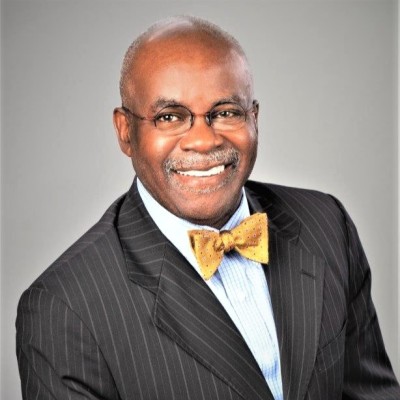
Yele Aluko MD, MBA, FACC
Dr. Aluko is a board-certified interventional cardiologist, chief medical officer at EY, and director of the EY Center for Health Equity. He is a member of the EHI Board of Advisors.
These views expressed by the author are not necessarily those of Ernst & Young LLP or other members of the global EY organization.
Protecting Health Data Outside the Healthcare System
Overview
Since the early 2000s, the Health Insurance Portability and Accountability Act (HIPAA) has been the nation’s primary health privacy law, protecting patient data held by the healthcare system – hospitals, doctors, clinics, and health insurers.
With the explosive proliferation of digital technologies, an ever-increasing amount of health data is generated by consumers themselves. This data is both held and used by companies that are not bound by the obligations of HIPAA, leaving that data largely under-protected and under-regulated.
With the generous support of the Robert Wood Johnson Foundation (RWJF), the Executives for Health Innovation and the Center for Democracy & Technology (CDT) released the Consumer Privacy Framework for Health Data (the Framework) in February of 2021. The Framework outlines the current gaps in legal protections and discusses how non-HIPAA-covered health data should be used, accessed, and disclosed. A second round of funding from RWJF led to the development of the final report, The Case for Accountability: Protecting Health Data Outside the Healthcare System, authored by EHI.
The Final Report
EHI’s report makes the case for why a robust accountability mechanism is needed to govern the use of health data held and used by health tech companies. In the absence of new federal data privacy legislation, EHI has put forward a private-sector solution – a neutral, independently run self-regulatory program that will oversee the data use policies and procedures of Framework members.
Self-Regulatory Program
In January 2022, EHI launched a Request for Proposals from organizations interested in housing and running the Framework’s self-regulatory program. After careful consideration of the proposals submitted by an independent, objective committee of experts, EHI announced that it had selected BBB National Programs to implement and house this new program, overseeing compliance with the Framework and protecting consumer health data not bound by the obligations of HIPAA
Press Releases
- 2/09/2021: CDT and EHI Release Proposed Consumer Privacy Framework for Unprotected Health Data
- 1/24/2022: EHI Announces RFP to Launch Program Recommended in Consumer Privacy Framework
- 3/24/2022: EHI Releases Report: The Case for Accountability: Protecting Health Data Outside the Healthcare System
Reports
- 2/09/2021: CDT & EHI’s Proposed Consumer Privacy Framework for Health Data
- 3/24/2022: The Case for Accountability: Protecting Health Data Outside the Healthcare System
Webinars
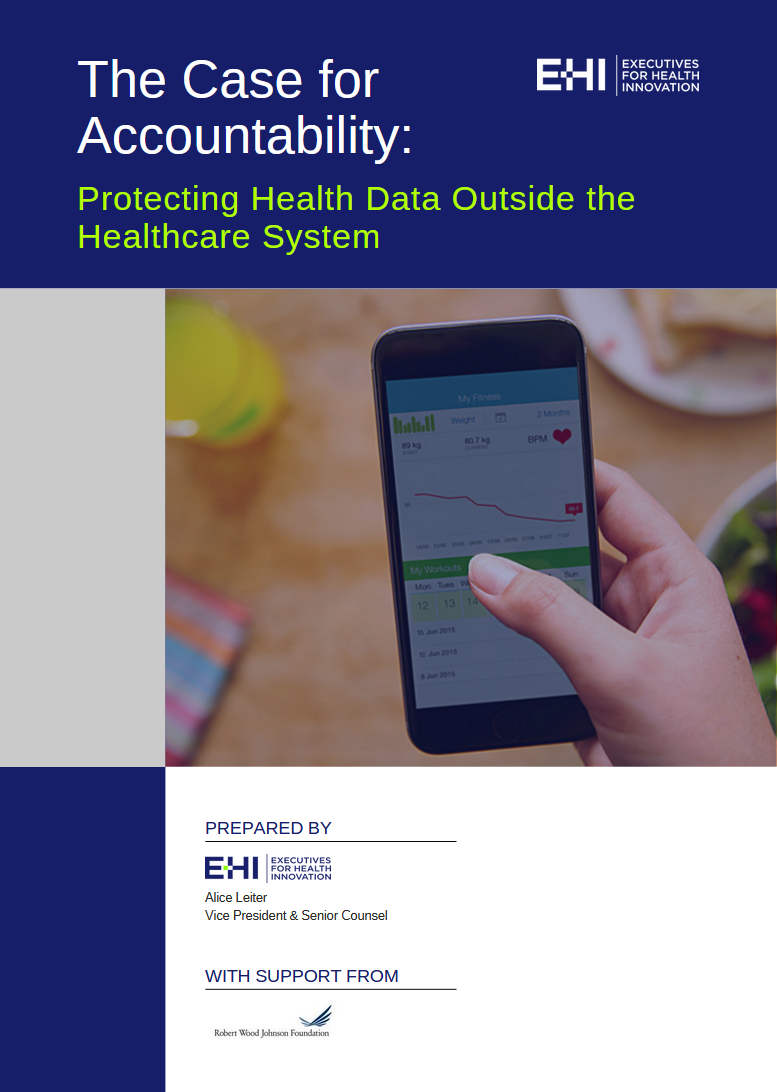
Report: Addressing Inequity in Cancer Care
Overview
Inequities in cancer research and care are widespread. As more clinical data is analyzed and collected, the gaps in care for vulnerable communities have only become more glaring. A 2022 BMC Public Health study found that cancer survival rates were lower for individuals living in both a high-income country and a resource-deprived community (BMC Public Health 2022). Statistics and studies like this are bolstering research initiatives across the country.
In a recent, multi-stakeholder roundtable, Executives for Health Innovation (EHI) convened leading experts to address the widening gaps that exist in oncology care and screening for those in vulnerable populations. The attendees addressed the need for collaboration between public and private industries (including Moonshot 2.0) to make meaningful changes and improvements.
A summary of the key concerns and highlights from the discussion are offered in this report.
With generous support from Philips
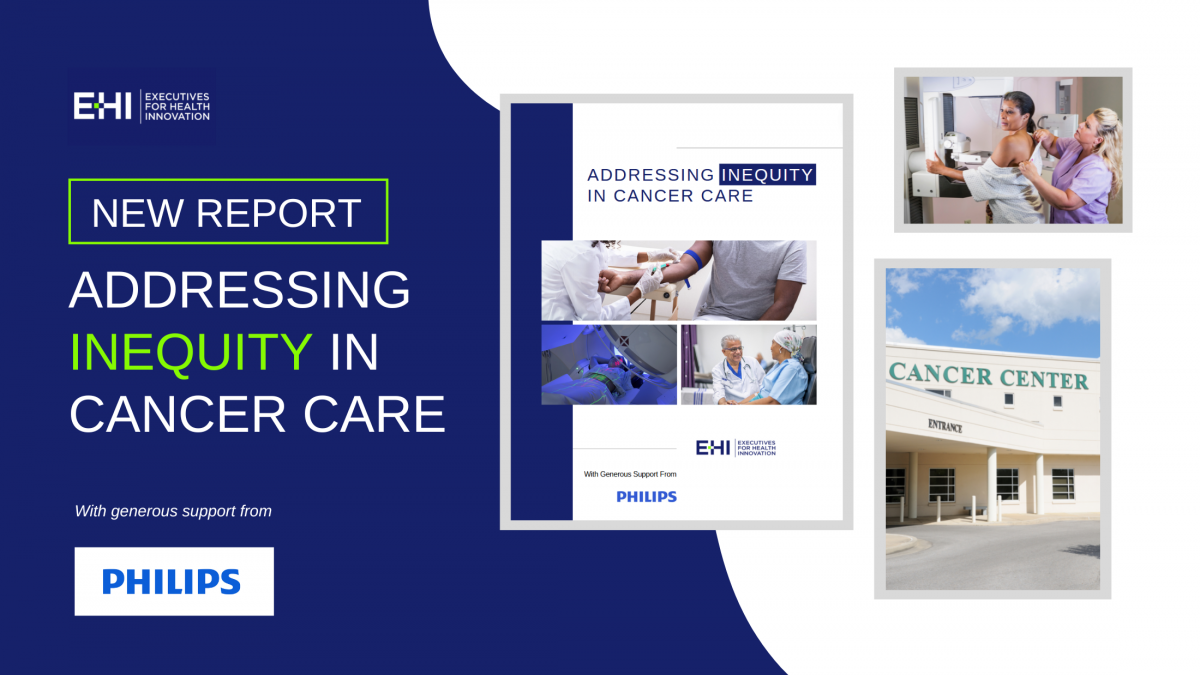
Executive Spotlight: A Deep Dive Into Upcoming Cybersecurity Legislation With Healthcare Executives
OVERVIEW
In 2022, Executives for Health Innovation (EHI) convened a small group of cybersecurity experts, regulators, and policy experts to discuss cybersecurity concerns facing the healthcare industry.
During this impressive roundtable, the group identified the top concerns driving executives, including:
- new guidance and regulations related to medical devices, healthcare systems, and patient data;
- the current legislative challenges facing Congress; and
- recent FDA draft guidance and pending legislation.
A summary of the key concerns and highlights from the discussion are offered in this report.
EHI thanks Booz Allen Hamilton for their generous support in convening and moderating this roundtable and their continued support of our organization’s work addressing cybersecurity challenges in healthcare.
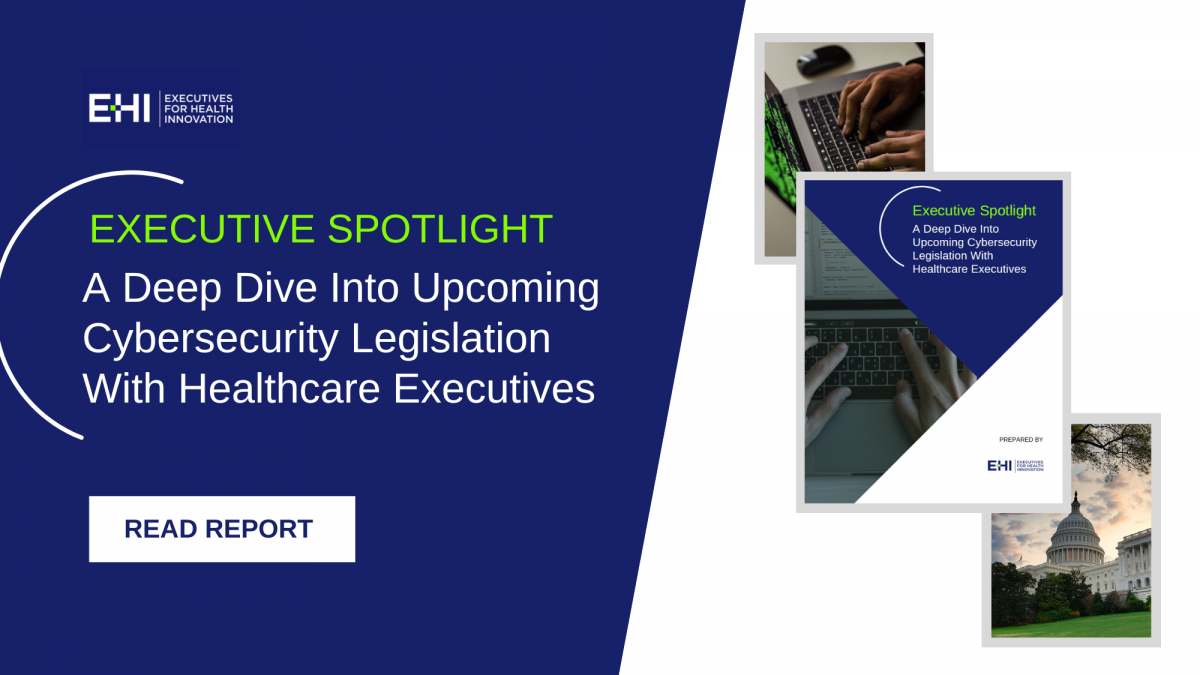
LexisNexis® Risk Solutions and EHI Release New Report on Cybersecurity
Washington, DC – July 13, 2022 - Today, LexisNexis® Risk Solutions and Executives for Health Innovation (EHI) released the report, Tackling Cybersecurity Threats Without Sacrificing Usability. The report contains insights from an Executive Roundtable panel comprised of cybersecurity experts from LexisNexis Risk Solutions; Marshfield Clinic Health System; Mayo Clinic; Office of the National Coordinator for Health IT (ONC); and Providence Health.

